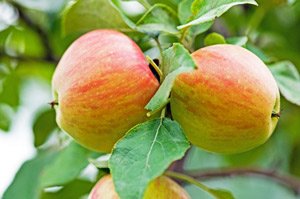Using AMAZE with LSB as a Foliar Program
Amazing Breakthrough in Foliar Plant Nutrition Part I - Case Study

Dwayne Bowman had a problem. Actually he had two. As a recent transplant from Ohio to the fruit tree region of Washington, and with no prior experience, his first job was to manage a large orchard producing apples and cherries. As Dwayne recounts “My wife knew more about fruit trees than I did when I got the job.”
To help overcome this problem Dwayne relied on the expertise of Wendell Owens at International Ag Labs. He was determined to follow the exact fertility recommendations given by Wendell accompanying the soil tests.
Dwayne’s second problem had to do with the orchard itself; alternate bearing. One year the orchard would produce somewhat acceptable yields followed by a year of dismal production. This economic killer is an all-too-common problem of modern orchard production. To further compound the economic problems the most lucrative aspect of the orchard, Honeycrisp apples, was suffering from a deplorable 25% culling loss due to bitter pit.
Yields Tell the Story
A particular block of Honeycrisp apples tells an amazing story. In 2005, the orchard yielded 27 bins per acre. In 2006 it yielded only 9 bins. This was clearly the off year in the alternate bearing cycle. In 2007 production was at 13 bins per acre. In 2008, the first year Dwayne took over the management, Honeycrisp apples averaged 40 bins per acre. This very respectable yield was coupled with an astounding decline in bitter pit loss to less than 1%. Since this harvest was on the top side of the alternate bearing cycle the real test would come next year. By 2009 the harvest pushed even higher; 44 bins per acre with the same low rate of bitter pit. Clearly the cycle of alternate bearing was broken. Unfortunately the chemical thinner used to take excess blossoms off the tree was over applied.
In 2010 Dwayne decided to quit using the chemical blossom thinner and instead had a certain percentage of blossoms thinned by hand. Yields for 2010 went 70 bins per acre.
The Fertility Program
What brought about this remarkable change in the orchard? Bowman credits management and appropriate fertility. The fertility program is actually quite simple. After the soil is tested a custom fertilizer blend is mixed and broadcasted once a year. The best time is just after harvest. The second component of the fertility program is to foliar feed dilute nutrient solutions through the leaves.
Apple Quality
 Most apples are notoriously short on calcium. This shows up as mushy apples that have little flavor or shelf life. To compensate, the industry has subjected some of these apples to a pressure treatment of liquid calcium chloride. This treatment forces calcium inside the apple with better shelf life as a result. It also leaves a bitter aftertaste—literally. This is why most Red Delicious apples taste terrible even though they look so nice.
Most apples are notoriously short on calcium. This shows up as mushy apples that have little flavor or shelf life. To compensate, the industry has subjected some of these apples to a pressure treatment of liquid calcium chloride. This treatment forces calcium inside the apple with better shelf life as a result. It also leaves a bitter aftertaste—literally. This is why most Red Delicious apples taste terrible even though they look so nice.
Among apple varieties the Honeycrisp demands higher calcium levels in the apple. When this need is not met bitter pit results. With respect to quality a far better approach is to produce apples with high levels of calcium deposited into the apple while it is growing. This is exactly what Dwayne did by following the foliar program.
AMAZE to the Rescue
AMAZE is a 5-16-4 crystal-clear foliar spray. It is a true solution and has a broad spectrum of trace minerals and 5 units of calcium. AMAZE is unique because it combines plant-available phosphate with soluble calcium. By combining the calcium with the phosphate the calcium becomes mobile in the plant. Where does the calcium migrate to? That’s right… straight to the fruit.
Wendell’s foliar spray program was actually quite simple. Apply 2 quarts of AMAZE with 30 gallons of water along with 3 lbs. of dissolved dextrose and 1 quart of LSB. Apply weekly. Instead of applying this to every row Dwayne applied it to every other row. Later in the week he repeated the application down the skipped rows. This resulted in all the trees getting 75% coverage 2 times per week. Results were quite impressive. In the first year Dwayne did an experiment on Fuji apples by not foliar spraying several rows in a block that that had been given the recommended broadcast. Foliar spraying resulted in a 10% yield increase and more importantly in a 10% increase in apple sizing.
Your Turn
Dwayne was so impressed with AMAZE and the fertility program he became a dealer for International Ag Labs in Washington and is now helping other growers. What about you? Can an effective foliar spray that provides mobile calcium in a plant help your operation? Take action now for profitable returns in the future.
Call 507-235-6909 or emailThis email address is being protected from spambots. You need JavaScript enabled to view it.




